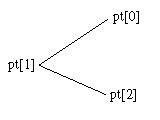
LAnnProtractor::GetPoints
#include "ltwrappr.h"
virtual L_INT LAnnProtractor::GetPoints(pPoints)
|
pANNPOINT pPoints; |
/* pointer to an array */ |
Fills the specified array of ANNPOINT structures with the endpoints of the ruler object. This function is available in the Document/Medical Toolkits.
|
Parameter |
Description |
|
pPoints |
Pointer to the array to be filled with the vertices of the protractor object. |
Returns
|
SUCCESS |
The function was successful. |
|
< 1 |
An error occurred. Refer to Return Codes. |
Comments
The ANNPOINT structure is like a Windows POINT structure, except that it uses double-precision floating point values.
Coordinates of an object's points are relative to its container object. The coordinates are interpreted using the container's scaling factors and offsets, which are described in Low-Level Coordinate System for Annotations.
The order of the vertices in the array is shown below:

Required DLLs and Libraries
|
LTANN For a listing of the exact DLLs and Libraries needed, based on the toolkit version, refer to Files To Be Included With Your Application. |
See Also
|
Functions: |
|
|
Topics: |
Annotation Functions: Getting and Setting Geometric Properties |
|
|
Annotation Functions: Using Window Coordinates to Define an Object |
|
|
|
|
|
Example
L_INT LAnnProtractor_GetPointsExample()
{
LBitmap MyBitmap;
LSettings::UnlockSupport(L_SUPPORT_DOCUMENT, L_KEY_DOCUMENT);
LAnnProtractor MyAnnProtractor;
ANNPOINT MyPts[3] = { 40,40,
140,40,
140,140
};
pANNPOINT pMyPts = MyPts;
MyAnnProtractor.SetPoints(pMyPts, 3);
L_UINT uPointCount = MyAnnProtractor.GetPointCount();
HGLOBAL hGlobal = GlobalAlloc(GMEM_MOVEABLE, sizeof(ANNPOINT) * uPointCount);
pANNPOINT pAnnPoint = (pANNPOINT)GlobalLock(hGlobal);
MyAnnProtractor.GetPoints(pAnnPoint);
for (unsigned int i=0; i<uPointCount; i++)
{
L_TCHAR szTemp[100];
wsprintf(szTemp, TEXT("[%d]Point(%d, %d)"), i, (int)pAnnPoint[i].x, (int)pAnnPoint[i].y);
AfxMessageBox(szTemp);
}
GlobalFree(hGlobal);
return SUCCESS;
}